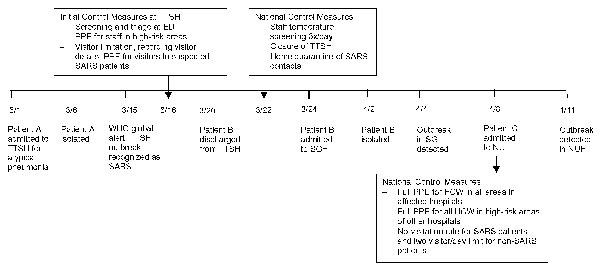Volume 10, Number 3—March 2004
Perspective
SARS Transmission and Hospital Containment
Figure 2

Figure 2. Timeline of events in the outbreak of SARS in the three acute hospitals, Singapore March–May 2003. SARS, severe acute respiratory syndrome; TTSH, Tan Tock Seng Hospital; ED, emergency department; PPE, personal protective equipment (defined as a test-fitted N95 mask, gowns, and gloves; goggles if dealing with suspicious cases; powered air purified respirators for high-risk procedures such as intubation); ICU, intensive care unit; high-risk area defined as ED, ICU, isolation wards; SGH, Singapore General Hospital; NUH, National University Hospital; HCW, healthcare worker. Staff found to have a temperature >37.5°C were given medical leave for 3 days with a review on the third day.
Page created: February 08, 2011
Page updated: February 08, 2011
Page reviewed: February 08, 2011
The conclusions, findings, and opinions expressed by authors contributing to this journal do not necessarily reflect the official position of the U.S. Department of Health and Human Services, the Public Health Service, the Centers for Disease Control and Prevention, or the authors' affiliated institutions. Use of trade names is for identification only and does not imply endorsement by any of the groups named above.